
Our always popular Action Philosopher “Plato Smash!” t-shirts are now back in stock after being out of print for a while – now available in youth and adult XXL sizes! More designs will be added soon!
you can discover your new favorite mini comic and get to know the artist personally.

 This week: Finally, the printer!
This week: Finally, the printer! 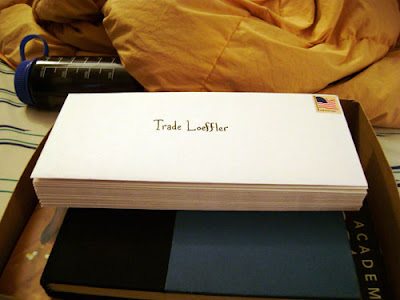 I sent these out a couple days ago, so if you don't get it in a couple weeks, maybe longer for the folks in Germany, Britain, Canada and Israel, let me know.
I sent these out a couple days ago, so if you don't get it in a couple weeks, maybe longer for the folks in Germany, Britain, Canada and Israel, let me know.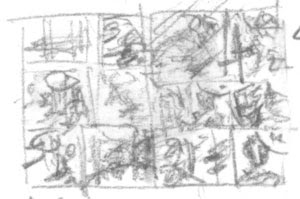 Obviously this isn't very helpful to an editor and writer who might like to actually see how I'm adapting the story into comics form.
Obviously this isn't very helpful to an editor and writer who might like to actually see how I'm adapting the story into comics form.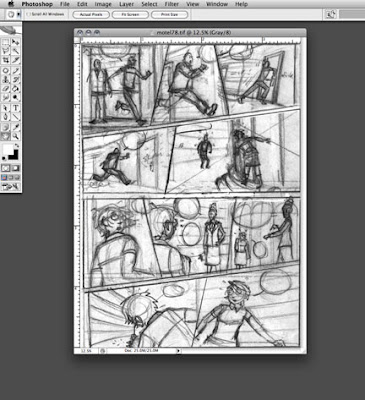 Jason then takes these layouts and converts the lines to pure cyan, and then drops the file into illustrator, where he begins positioning balloons and panels.
Jason then takes these layouts and converts the lines to pure cyan, and then drops the file into illustrator, where he begins positioning balloons and panels.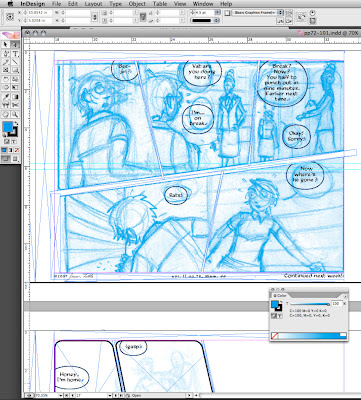
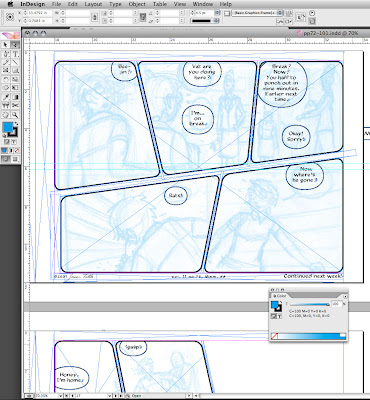
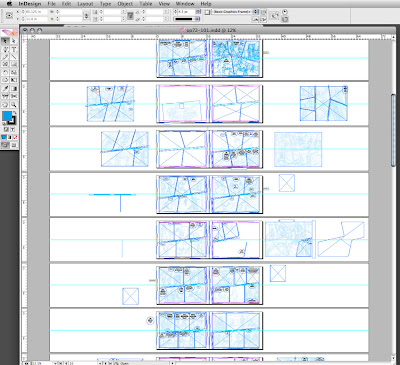 As you'll see, Jason prints his layouts out much darker than me, which has to do both with that we'll both use different tools for our finished pencils, but also in how we like to build up a drawing. You can see how he prints the borders and balloons onto the illustration board.
As you'll see, Jason prints his layouts out much darker than me, which has to do both with that we'll both use different tools for our finished pencils, but also in how we like to build up a drawing. You can see how he prints the borders and balloons onto the illustration board.
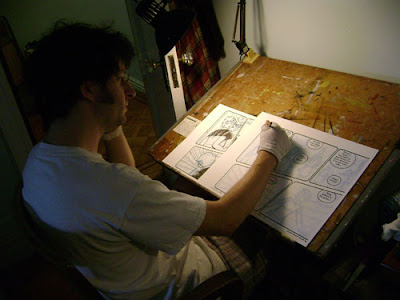 The blue pencil makes a slightly darker line than the cyan printout, so it's easy for Jason to refine the drawing. This is one place where Jason and I differ big time- I am NOT one of those artists who can draw a bunch of lines and then pick one. I always pick wrong when I try it, every single time. I draw a line, and if it doesn't work, I erase it. If I need to re-draw something, I erase and do again. My mind can't handle the clutter. You'll notice Jason wears a cotton glove to avoid smudging his oils onto the paper, and to avoid smudging the pencils as well.
The blue pencil makes a slightly darker line than the cyan printout, so it's easy for Jason to refine the drawing. This is one place where Jason and I differ big time- I am NOT one of those artists who can draw a bunch of lines and then pick one. I always pick wrong when I try it, every single time. I draw a line, and if it doesn't work, I erase it. If I need to re-draw something, I erase and do again. My mind can't handle the clutter. You'll notice Jason wears a cotton glove to avoid smudging his oils onto the paper, and to avoid smudging the pencils as well. At this point he started inking. You can see the sharper, darker pencil lines.
At this point he started inking. You can see the sharper, darker pencil lines.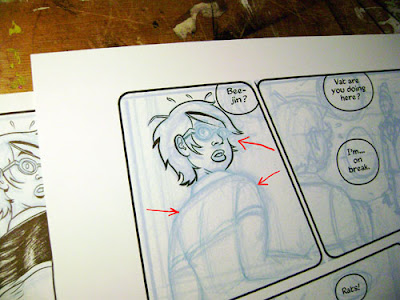
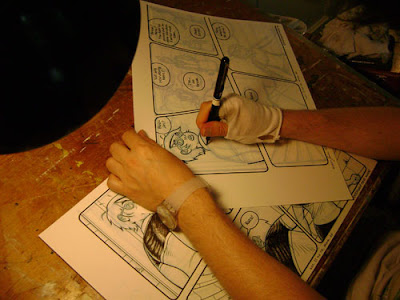 And here is Jason with the finished page from the comic:
And here is Jason with the finished page from the comic: Matt's process
Matt's process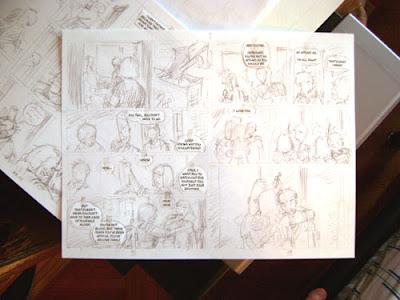

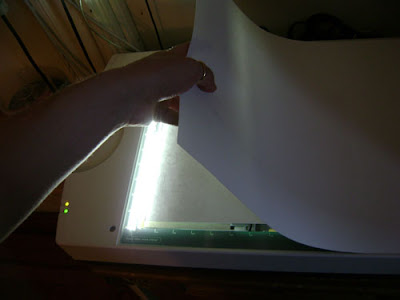
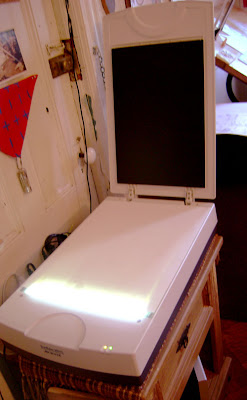 Here in my scanner settings you can see that I've chosen to define the scanner boundary in pixels. Those numbers correspond to the first scan of my thumbnails that I did, and because I like to be able to handle every single file in the exact same way, I make all my thumbnail scans an identical number of pixels, rather than hand selecting the bounding box each time. Consistency is awesome when working with computers. Computers don't really do happy accidents.
Here in my scanner settings you can see that I've chosen to define the scanner boundary in pixels. Those numbers correspond to the first scan of my thumbnails that I did, and because I like to be able to handle every single file in the exact same way, I make all my thumbnail scans an identical number of pixels, rather than hand selecting the bounding box each time. Consistency is awesome when working with computers. Computers don't really do happy accidents.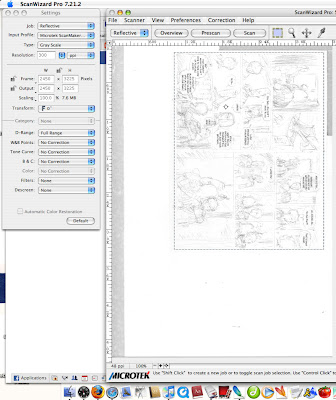 All my scanned thumbs go into a folder called Rawthumbs300. This indicates that these are raw files to be kept unmodified in this folder, so that they'll always be around to be turned into a veriety of products, such as web-viewable thumbnails for my editor, or blueline files for my printer. The 300 indicates the DPI I scan them at. I don't use the First Second naming convention I use on all the other files, to emphasize that these are separate raw product not to be touched. Book 1 and book 2 of my project have separate rawthumbs300 files.
All my scanned thumbs go into a folder called Rawthumbs300. This indicates that these are raw files to be kept unmodified in this folder, so that they'll always be around to be turned into a veriety of products, such as web-viewable thumbnails for my editor, or blueline files for my printer. The 300 indicates the DPI I scan them at. I don't use the First Second naming convention I use on all the other files, to emphasize that these are separate raw product not to be touched. Book 1 and book 2 of my project have separate rawthumbs300 files.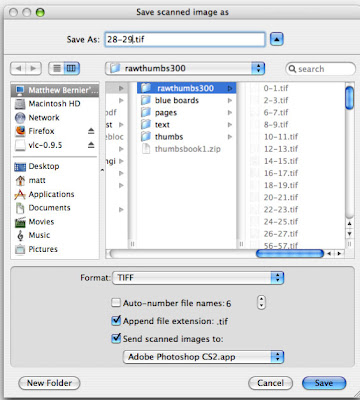
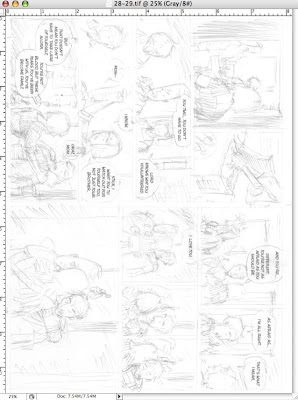


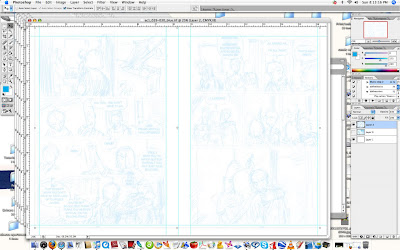 And here's the actions I have set up. You can see I have them set to run by key command, so I don't need to find the action in the list and click on it every time:
And here's the actions I have set up. You can see I have them set to run by key command, so I don't need to find the action in the list and click on it every time: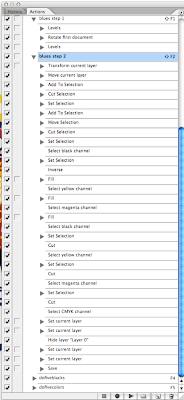 Not it's time to print. See that big clot of pages below my printer? Those are the hand-cut illustration boards for my entire first book.
Not it's time to print. See that big clot of pages below my printer? Those are the hand-cut illustration boards for my entire first book.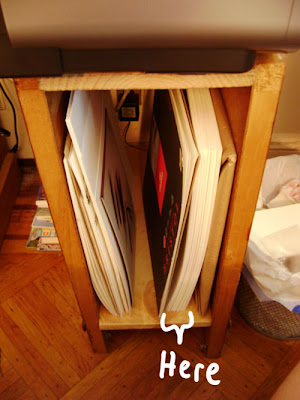 Two important things about my print settings for this. One, I turn color correction off. If you try to print pure cyan with color correction on, the computer will try to make it more visually pleasing with some magenta dots here and there that you won't see until they make a mess of your scans.
Two important things about my print settings for this. One, I turn color correction off. If you try to print pure cyan with color correction on, the computer will try to make it more visually pleasing with some magenta dots here and there that you won't see until they make a mess of your scans.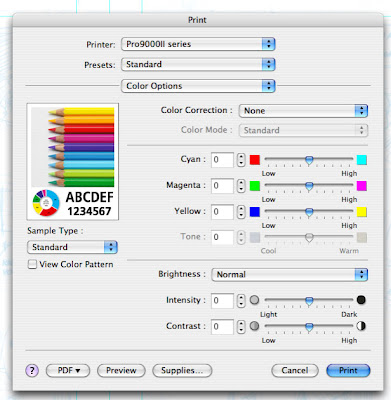 Next, I want to use as little ink as possible, and since no one will see this stage of the art I set the print quality to fast. In order to do this I have to lie and say I'm using plain paper, but the bristol causes no damage to the printer. I'll also note, though it's not shown, that I have a special paper size selection custom made for these pages, the result being the prints land exactly where I want them on the page every single time.
Next, I want to use as little ink as possible, and since no one will see this stage of the art I set the print quality to fast. In order to do this I have to lie and say I'm using plain paper, but the bristol causes no damage to the printer. I'll also note, though it's not shown, that I have a special paper size selection custom made for these pages, the result being the prints land exactly where I want them on the page every single time.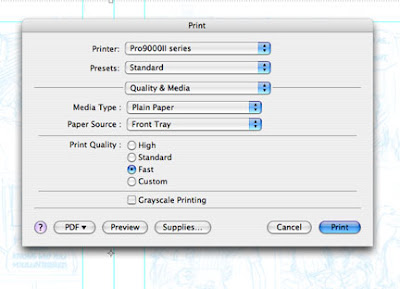 Here's my blank illustration board (except for page numbers written on it in pencil below where the pages will be) in the printer's dedicated large media path, which is FLAT. No bending!
Here's my blank illustration board (except for page numbers written on it in pencil below where the pages will be) in the printer's dedicated large media path, which is FLAT. No bending!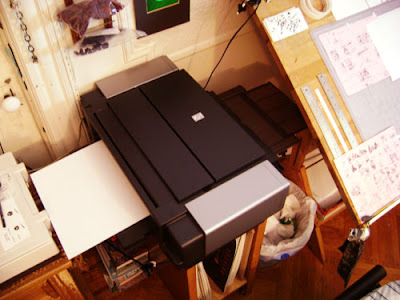 And here's the result:
And here's the result: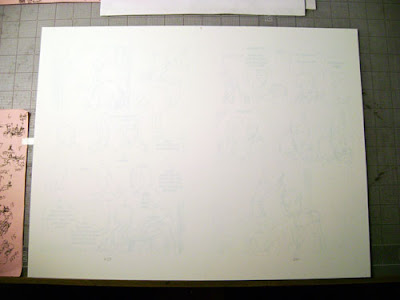
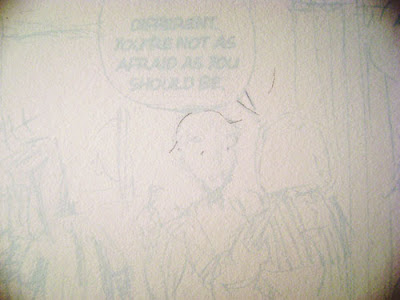 And without having to apply pressure to the eraser, they go away:
And without having to apply pressure to the eraser, they go away: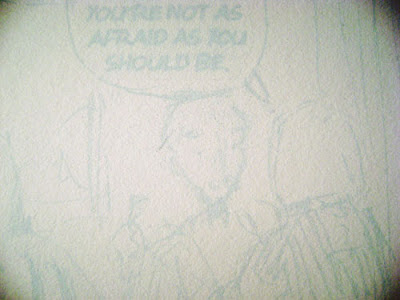
 This Week: Eraser Rub Off
This Week: Eraser Rub Off

 It has a dedicated paper path for large format and thick media, and here you can see my first print going through it!:
It has a dedicated paper path for large format and thick media, and here you can see my first print going through it!:



 Next, I did a careful erasing of each, not stopping until I had gotten all the pencil totally gone. If you click to see the image below larger, you'll really see some differences in the scan. The Staedtler could not get all the pencil out, at all. It was too hard to press into the lines, and not sticky enough to grab the pencil lead. This test of the Foam seemed to confirm what Joe had said, which is that the Foam is TOO sticky- it sticks to the ink and starts pulling it from the paper when you use it roughly. You can see that the lettering has been compromised. I also rubbed off a LOT of eraser doing the job. The Tombo Mono, Joe's favorite in his own tests, looks great here, and worked nearly 3 times as fast as any of the others while leaving no ink damage. The pencil was gone out of the deepest gouges in a few passes. The Non-Dust Tombo didn't fare too badly either, although I rubbed off a lot more of the eraser doing the same job as the regular Tombo, which means I'd have to buy more of them.
Next, I did a careful erasing of each, not stopping until I had gotten all the pencil totally gone. If you click to see the image below larger, you'll really see some differences in the scan. The Staedtler could not get all the pencil out, at all. It was too hard to press into the lines, and not sticky enough to grab the pencil lead. This test of the Foam seemed to confirm what Joe had said, which is that the Foam is TOO sticky- it sticks to the ink and starts pulling it from the paper when you use it roughly. You can see that the lettering has been compromised. I also rubbed off a LOT of eraser doing the job. The Tombo Mono, Joe's favorite in his own tests, looks great here, and worked nearly 3 times as fast as any of the others while leaving no ink damage. The pencil was gone out of the deepest gouges in a few passes. The Non-Dust Tombo didn't fare too badly either, although I rubbed off a lot more of the eraser doing the same job as the regular Tombo, which means I'd have to buy more of them.

 Here's the scant and manageable dust left by the Tombo Mono:
Here's the scant and manageable dust left by the Tombo Mono: And here's the notably long strands of rubber left by the Non-Dust:
And here's the notably long strands of rubber left by the Non-Dust:

 This week: Balloon Shape.
This week: Balloon Shape. The problem on the top left is different from all the others in that it's a mistake made by cartoonists who are just starting to try to address the relationship of their text to the balloon but don't quite have the hang of it. I did it for awhile and so did many of my classmates at SVA. It happens when you keep drawing your balloons around your words and leaving huge amounts of space around them here but almost crashing the edge against a letter somewhere else. The teacher or a fellow student will say "You need to be leaving more equal space around your words, imagine there's a forcefield around the letters you can't cross." But then you take them too literally and you draw these spandex-fit balloons that really are like drawing a forcefield around the text.
The problem on the top left is different from all the others in that it's a mistake made by cartoonists who are just starting to try to address the relationship of their text to the balloon but don't quite have the hang of it. I did it for awhile and so did many of my classmates at SVA. It happens when you keep drawing your balloons around your words and leaving huge amounts of space around them here but almost crashing the edge against a letter somewhere else. The teacher or a fellow student will say "You need to be leaving more equal space around your words, imagine there's a forcefield around the letters you can't cross." But then you take them too literally and you draw these spandex-fit balloons that really are like drawing a forcefield around the text. Alright, now below are those same arrangements, but with the shape of the letters emphasized:
Alright, now below are those same arrangements, but with the shape of the letters emphasized: 1 is just a boring shape, and being rectangular it's hard to form a pleasing oval around. But it used space pretty efficiently, so I marked it as lukewarm, a shape I might use is I had to but one I'd avoid when composing my page.
1 is just a boring shape, and being rectangular it's hard to form a pleasing oval around. But it used space pretty efficiently, so I marked it as lukewarm, a shape I might use is I had to but one I'd avoid when composing my page.

 Using very regular, innocuous text also make composing much easier. However, as anyone who's read my comics knows, I DO think there's times where it's appropriate to draw attention to the text for effect:
Using very regular, innocuous text also make composing much easier. However, as anyone who's read my comics knows, I DO think there's times where it's appropriate to draw attention to the text for effect: I think a lot of folks associate bad lettering with digital, or computer lettering, either as seen in crappy mainstream comics or in englich Manga translations where the letterer is rarely an artist, such as these examples:
I think a lot of folks associate bad lettering with digital, or computer lettering, either as seen in crappy mainstream comics or in englich Manga translations where the letterer is rarely an artist, such as these examples: They're hilariously bad, to be sure. But let's not forget that plenty of great artists who did all their lettering by hand have made the same mistakes. Bill Watterson constantly ran out of room and had to bodge the rest of a long word in by drawing all the letters small, and Winsor McCay, one of the greatest cartoonists of all time, may well have been the worst letterer of all time. (Which is odd, since his title lettering was breathtaking. I think it's because he thought of the titles as drawing and his balloons as text.)
They're hilariously bad, to be sure. But let's not forget that plenty of great artists who did all their lettering by hand have made the same mistakes. Bill Watterson constantly ran out of room and had to bodge the rest of a long word in by drawing all the letters small, and Winsor McCay, one of the greatest cartoonists of all time, may well have been the worst letterer of all time. (Which is odd, since his title lettering was breathtaking. I think it's because he thought of the titles as drawing and his balloons as text.) I think it's just easier to see mistakes in digital lettering, and that mistakes look worse in digital lettering, because everything is so regular and clean. Doing things by hand gives you a little leeway.
I think it's just easier to see mistakes in digital lettering, and that mistakes look worse in digital lettering, because everything is so regular and clean. Doing things by hand gives you a little leeway. They're immaculate. They sit there like perfect jewels. I envy the shit out of this guy. You can't see it here, but his colors make me foam at the mouth with jealous rage too.
They're immaculate. They sit there like perfect jewels. I envy the shit out of this guy. You can't see it here, but his colors make me foam at the mouth with jealous rage too. Sometimes he'll let them get wider and grow into fat circles, but unlike just about every letterer I've ever seen, O'Malley defaults to the vertical, rather than the horizontal. The result is that instead of reading a block of text, I meander through the character's words as they speak. It makes for a unique reading experience.
Sometimes he'll let them get wider and grow into fat circles, but unlike just about every letterer I've ever seen, O'Malley defaults to the vertical, rather than the horizontal. The result is that instead of reading a block of text, I meander through the character's words as they speak. It makes for a unique reading experience.